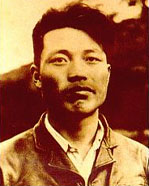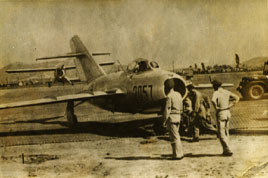|
FLIGHT TO FREEDOM
America's First MiG
As he finalized his flight planning, Lt. No set his mind to the goal of flying his MiG to Kimpo AFB, Seoul, Korea. The base was a good choice, not far across the border. Kimpo was home to the 4th Fighter Wing's F-86 Sabre squadrons and the 67th Tac Recon Wing, flying RF-86s, RF-80s, WB-26C and RB-26C Invaders, as well as base for the Australian contingent, the 77th RAAF Squadron, flying Meteors. It was a risky mission -- if any of the American or Australian pilots spotted his MiG, he would almost certainly be shot down. Lt. No climbed into the cockpit of MiG number 2057, and quickly completed his preflight checks. He waved for engine start. Before taxiing toward the runway, he glanced beneath his gunsight and saw the red letters of the words written there, "Pour out and zero in this vindictive ammunition to the damn Yankees." He pushed forward the throttle -- not today, there would be no combat with the Americans.
HEADING SOUTH
He pulled the plane off the runway and was surprised to see a ground crewman, mistaking the MiG for an F-86, wave him in toward the ramp. Ignoring the signal, he shut down the engine and stood up in the cockpit, his arms held up to surrender. Across the base, dozens of pilots and aircrews had seen the MiG. They knew exactly what it was. Now, they were piling into Jeeps and trucks and careening across the base for a closer look. Many brought their cameras, eager to capture a moment of history on film. The excitement of the moment was palpable. The control tower at Kimpo was already in action. The pilots in the two ready F-86s on the ramp called in that a MiG had just landed. The tower scrambled everything they had. Within minutes, the entire 4th Fighter Wing was airborne, as was the 77th RAAF Squadron of Australian Meteors. The squadrons took off one after another and established an extensive combat air patrol to defend the skies around the base. Shortly thereafter, other squadrons and wings from other bases were scrambled as well. There would be no opportunity given to the Soviets or North Koreans to attack and destroy the MiG on the ground at Kimpo.
The Air Police quickly secured the area, took the pilot away, and moved the plane into a nearby hangar to hide it from the North. Of the numerous photographs taken at the scene, the Air Police did an excellent job of stripping film. Forty years later, the Wright-Patterson AFB Museum had but one photograph of the plane as it appeared right after it landed. This one shot, taken at a distance from a passing truck, gave but a blurred account of the MiG on the ground. The ultimate prize was in hand -- America's first MiG, primed and ready for study and evaluation. Incredibly, the plane still had fuel on board and its guns were fully loaded. In effect, the MiG was a frontline, combat-ready airplane -- a unique windfall. Within the day, the MiG was gone. A cargo plane was brought in to fly it to Okinawa for testing. |
|
|
 It was the morning of September 21, 1953. For Lt. Kum Sok No, a 21-year old, elite North Korean Air Force MiG pilot, the dawn heralded anything but just another day. As he poured over operational orders and charts, his mind was racing. Today would be the day that he would take his airplane, Russia's finest and most secret jet fighter, the MiG-15, to the South and defect.
It was the morning of September 21, 1953. For Lt. Kum Sok No, a 21-year old, elite North Korean Air Force MiG pilot, the dawn heralded anything but just another day. As he poured over operational orders and charts, his mind was racing. Today would be the day that he would take his airplane, Russia's finest and most secret jet fighter, the MiG-15, to the South and defect.
 Suddenly, he broke formation and dove for freedom. With Seoul only about 50 miles south of the DMZ, he flashed into UN territory at top speed. At more than 550 mph, the MiG was flying south at a rate of about one mile every six seconds -- it would be just four tense minutes after crossing the border. He spotted Kimpo AFB and came straight in, ignoring the traffic pattern. He actually landed downwind, opposite the direction of the pattern -- if an F-86 had been on the runway, they would have collided. He landed hot and fast, but he had made it -- he was on the ground.
Suddenly, he broke formation and dove for freedom. With Seoul only about 50 miles south of the DMZ, he flashed into UN territory at top speed. At more than 550 mph, the MiG was flying south at a rate of about one mile every six seconds -- it would be just four tense minutes after crossing the border. He spotted Kimpo AFB and came straight in, ignoring the traffic pattern. He actually landed downwind, opposite the direction of the pattern -- if an F-86 had been on the runway, they would have collided. He landed hot and fast, but he had made it -- he was on the ground.
 Despite the scramble of the base's fighter squadrons, Kimpo itself was abuzz. Four personnel from the base recon squadrons were already beside the MiG, having arrived even before the Air Police. Now, seeing the flashing lights of the approaching APs, they piled back into their Jeep and drove off, leaving the stunned pilot still standing in the cockpit, hoping to surrender to somebody. Ground crewman were heading to the plane as fast as they could. One of the 11th Tac Recon pilots, Lt. Gene Johnson, was riding his bicycle down a nearby taxiway and when he saw the MiG. He pedaled up and was one of the first there, even before the MiG pilot had stepped out of the plane. It wasn't long before a small crowd had gathered.
Despite the scramble of the base's fighter squadrons, Kimpo itself was abuzz. Four personnel from the base recon squadrons were already beside the MiG, having arrived even before the Air Police. Now, seeing the flashing lights of the approaching APs, they piled back into their Jeep and drove off, leaving the stunned pilot still standing in the cockpit, hoping to surrender to somebody. Ground crewman were heading to the plane as fast as they could. One of the 11th Tac Recon pilots, Lt. Gene Johnson, was riding his bicycle down a nearby taxiway and when he saw the MiG. He pedaled up and was one of the first there, even before the MiG pilot had stepped out of the plane. It wasn't long before a small crowd had gathered.